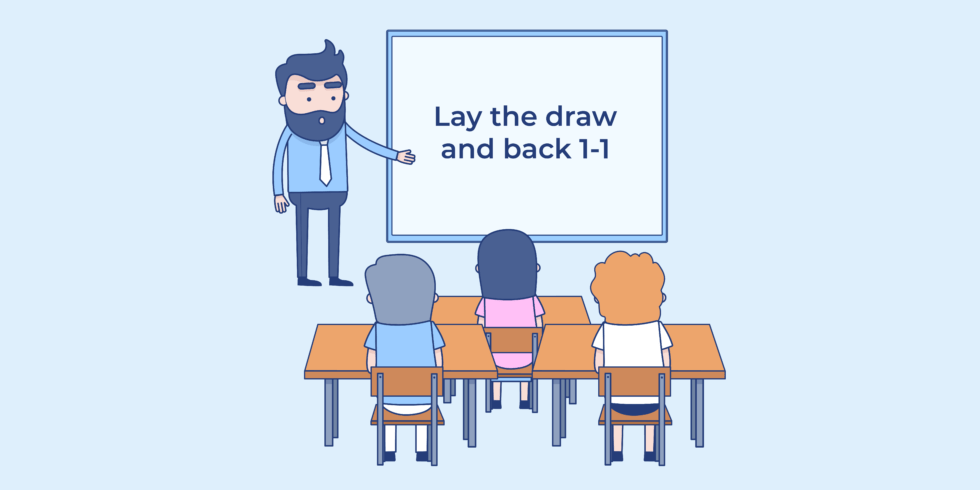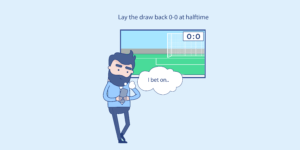The Laying the Draw (LTD) technique is a well-known and widely used method of making money from trading. It is used by both trading newbies and more experienced traders.
It is successful in making profits in the long run, especially with the proper selection of matches.
But what if we wanted to hedge our bet by backing the 1-1 correct score?
After all, statistics say that more than half of the matches that end in a draw end with a correct score of 1-1.
So how would our profit look if we hedged our bets this way and is backing 1-1 a profitable strategy?
Chapter 1
How does Laying the Draw and backing 1-1 work?

Let’s take a step-by-step look at:
- How to bet LTD back 1-1
- What costs do we incur?
- How much can we win?
- What are the possible final results?
Are you curious?
Let’s go!
Let’s say you’ve found the perfect match that, in terms of previous games, form, stats, and league table position, looks likely that it won’t finish in a draw.
So you place a lay bet at odds of @3.5 for £100 – your liability, in this case, will be £250.
If the match does not end in a draw, you win £100.
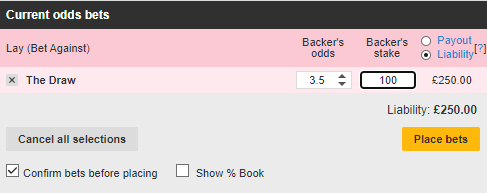
However, if you don’t want to risk your £240 fully, you can decide to invest an extra £10 and place a bet on 1-1 at odds @8.4.
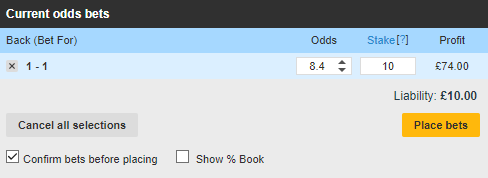
Let’s summarise the information gathered, the stakes, and the possible outcomes.
1. The match ends with a home or away victory:
You win £100 from Laying the Draw
You lose £10 from backing 1-1
Profit: £90
2. The match ends in a 1-1 draw
You lose £250 from Laying the Draw
You win £74 from backing 1-1
Profit: -£176
Of course, you can increase your back bet 1-1 beforehand, but what if…
3. The match ends in a 0-0 or 2-2 or 3-3 draw.
You lose £250 from Laying the Draw
You lose £10 from backing 1-1
Profit: -£260
The above calculations omit commissions, which vary depending on the country and the betting exchange selected.
As you can see, backing 1-1 can make a lot of sense, provided the match does not end with a very unfavourable result such as 0-0, 2-2, 3-3 etc.
How much should we bet on a 1-1 back bet then?
The best strategy is to place a bet for one-third of the lay stake – in the example, above we are betting £100 on Lay The Draw at odds of 3.50, so a 1-1 back bet should be placed for £34 at odds of 8.4.
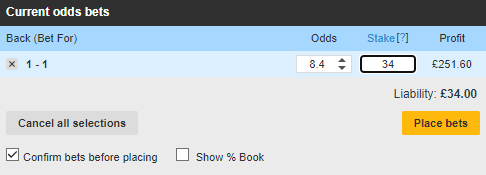
How do the wins look in this case?
| Final Results | Home or Away wins | 1-1 Draw | 0-0 or 2-2 or 3-3 etc. |
| You lose | £34 from 1-1 Back Bet | £250 from LTD Bet | £250 + £34 (LTD + 1-1 Back Bet) |
| You win | £100 from LTD Bet | £251.60 from 1-1 Back Bet | £0 |
| Overall Profit | £66 | £1.60 | -£284 |
Treating a final score of 1-1 as basically a refund, the above calculations show that you will make money if every fifth (or less frequent) match ends in a score of 0-0, 2-2, 3-3 etc.
On the other hand, if one of those results occurs more often, you will lose money.
This is only the case with laying the draw at odds @3.5 and backing the 1-1 correct score at odds @8.4.
To do the calculation, divide the maximum loss (in our case, £284) by the maximum profit per match (£66).
This comes out at 4.3, which means that with this frequency of 0-0, 2-2, 3-3 full-time scores appearing, we will break even.

You may also like: How does lay the draw and back 0-0 at half time system works?
Chapter 2
Tips and Tricks from the Expert

Let’s find out!
Lay low and back high
This is an essential trading principle that I hope most of you already know, and it also applies to this strategy.

Our task is to place a lay bet on the draw at the lowest possible odds so that our liability is as low as possible.
On the other hand, we want to place a back bet on the 1-1 correct score at the highest possible odds so that the profit is also higher.
To do this, it is worth not accepting the suggested odds, but set your own and wait a while until it is matched, or leave the bet to be matched.

You may ask, “How to predict the correct scrore?”. In this article you’re going to find our answer to that question and much more!
10 minutes before kick-off
This is when most market activity occurs and, consequently, liquidity is much higher – this is the time when you should try to place your Lay and Back bets.
By placing your bets long before the start, you are exposing yourself to poorly placed odds by other exchange members who are just waiting for you to accept their bet to make money off you.
In addition, the longer the match progresses, the lower the liquidity, and there is a high probability that your bet will not be matched.
Chapter 3
Should I Use Lay The Draw and Back 1-1?

Let’s check it out!
In simple terms, backing 1-1 rarely makes sense, EXCEPT if you have excellent knowledge of a league and know that matches rarely end in scorelines of 0-0, 2-2, 3-3, with the vast majority of draws ending in 1-1.
Then the strategy makes a lot of sense.

Check other profitable trading strategiest in this article.
As you can see, we cannot clearly define whether a specific technique will bring more or less profit because it depends on the particular choice of matches.
Can you highlight a league where a 0-0, 2-2, 3-3 rarely occurs, and you’re able to extract more profit because of this method?
Let us know in the comments below!

